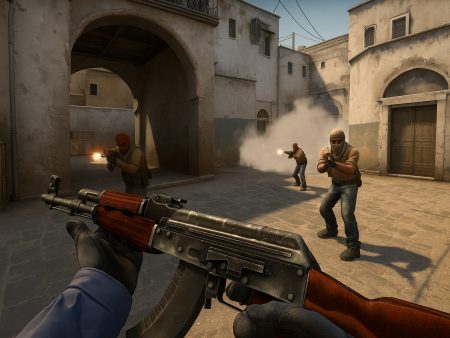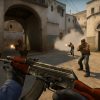Master the Ancient map in CS2 with this ultimate guide covering detailed callouts, pro tips, utility lineups, site strategies, and role-based tactics to dominate every match.
Ancient is one of the most visually striking and strategically dense maps in Counter-Strike 2 (CS2). Introduced in the later lifecycle of CS:GO and now optimized for CS2, Ancient has steadily climbed the ranks to become a favorite among both professional teams and ranked warriors. The map is set amidst ancient Mesoamerican ruins, providing a unique, lush aesthetic unlike anything else in the CS2 pool. But it’s not just about the visuals—Ancient introduces unique choke points, long sightlines, and narrow corridors that demand a balanced mix of aggression, map control, and team synergy.
The layout of Ancient is straightforward at first glance: two bombsites (A and B), a contested middle area, and relatively tight corridors leading into the sites. However, what sets Ancient apart is the depth of its mid control, the prominence of sound cues, and the massive tactical value of utility usage. Whether you’re grinding in Premier or watching pro matches, mastering Ancient is essential for climbing the ranks in CS2.
The biggest challenge with Ancient is its deceptive simplicity. New players often struggle with mid control, get picked in tight corridors, or fail to use utility efficiently. The map punishes solo play and rewards coordinated team efforts. Ancient thrives on timing, coordination, and callouts—making it a fantastic but demanding map to master.
Why Ancient Is Unique Compared to Other Maps

Ancient stands apart in several key areas:
- Compact Design with Extended Sightlines: Unlike maps like Inferno or Mirage, Ancient’s mid and B site areas offer long lines of sight that favor AWPers, but also include incredibly tight spaces like Cave and Jaguar, which are perfect for SMGs and shotguns.
- Heavily Contested Mid Control: Mid is everything on Ancient. It connects to both A and B sites and grants powerful rotation and flanking opportunities. Teams that fail to control or contest mid usually find themselves on the back foot.
- Audio-Centric Gameplay: The close quarters and stone flooring amplify footstep sounds, making stealth and timing more critical than ever. A single footstep can give away an entire strat if not careful.
- Tough Site Entries: Especially for Ts, cracking into either bombsite requires excellent utility and a well-timed push. There’s little room for error. Overcommitting or undercommitting can cost you the round.
- Unforgiving for Poor Rotations: Rotating from B to A (or vice versa) is not quick unless you hold mid. This makes over-rotating extremely dangerous, especially for CTs. Holding your ground is often better than risking a full rotation.
In short, Ancient demands coordination, map knowledge, and excellent communication—making it a dream for teams who play strategically and a nightmare for solo queue heroes without a mic.
Comprehensive Map Callouts
T-Side (Terrorist Side) Callouts
When you’re playing T-side on Ancient, understanding the layout and callouts is crucial for coordinating rushes, lurks, and site executions. Here’s a breakdown of all the important T-side areas and what you should know:
T Spawn
- This is your starting area each round. It’s pretty open but safe from early aggression.
- From T spawn, you can branch off into three primary directions: A main, B long (via Cave), or Mid (via Jaguar).
- Early utility setups often begin here—use this space wisely to plan your round and set up nades or smokes for mid or B site entries.
Cave, Jaguar, and Mid
- Cave is a narrow corridor leading toward B ramp. Great for SMGs, but dangerous for wallbangs.
- Jaguar connects T-side to Mid and is one of the most contested areas in the game. It’s a tight angle, but taking control of Jaguar can win rounds.
- Mid itself is a high-risk, high-reward area. It connects to Donut (leading to A) and Elbow (leading to B).
Pro Tip: Use early smokes and molotovs to deny CT mid control. If you lose mid, rotate strategies fast.
CT-Side (Counter-Terrorist Side) Callouts
Just like the T-side, CTs also have a defined set of crucial areas they must control and call out. Communication here is key to halting enemy pushes and coordinating rotations.
CT Spawn
- The central hub for rotations between A and B.
- Generally safe but often a choke point during fast rotations or site collapses.
- Smart CTs will use this area to drop utility for teammates or set up delayed rotations after gaining intel.
Donut, Temple, and A Site
- Donut is a key mid-to-A connector. Losing control of Donut means exposing A site to flanks and split pushes.
- Temple is a defensive post on A site—perfect for holding angles with a rifle or AWP.
- A Site itself is open and vulnerable without good coordination. Smokes on Temple, Donut, and Heaven can isolate defenders easily.
Watch out: Once Ts gain Donut control, defending A becomes significantly harder. Keep this area smoked or molied off regularly.
Neutral Areas
Neutral zones are those hotly contested by both sides. Holding or losing these areas can decide the outcome of a round.
Mid, Elbow, and Connector
- Mid: The lifeline of Ancient. Control it, and you control the map.
- Elbow: Connects mid to B site. Often used by Ts to lurk or apply pressure on CTs holding B.
- Connector: Allows rotations and crossfire setups. Usually smoked early in rounds.
B Ramp and B Site Callouts
- B Ramp: Leads into the site through Cave. Smokes and flashes are essential here.
- B Site: Very tight with lots of cover, making it great for site holds and difficult for Ts to clear without full utility.
Map Control and Territory Domination
Controlling Mid: The Key to Victory
Mid control on Ancient is not just important—it’s everything. Mid acts as the central nervous system of the map, offering rotation potential, lurk spots, and aggressive options for both teams. For Ts, controlling mid opens up split pushes onto both sites, while CTs use mid to deny this flexibility and reinforce sites quickly.
Why Mid Is Essential:
- Grants access to Donut and Elbow.
- Allows faster CT rotations.
- Enables T-side splits and fake plays.
T-Side Tips:
- Use a molotov to clear Jaguar.
- Flash over Mid doors.
- Have a lurker pressure Donut while teammates work Cave.
CT-Side Tips:
- Aggressively push Jaguar early.
- Pair a rifle with an AWPer holding Donut or Top Mid.
- Use one-way smokes to peek and fall back safely.
Controlling mid requires coordination and trust. One misstep, and you’re giving the other team the keys to the round.
A vs. B Site: Strategic Differences
Each site on Ancient presents its own unique challenges and playstyles. Let’s break down the differences:
A Site:
- Wide and open.
- Heavily reliant on Donut and Temple control.
- Easier for post-plants with proper utility.
- CTs need to hold aggressive angles or play retake with utility.
B Site:
- Cramped and full of cover.
- Entry is tough without Cave control.
- Ideal for SMGs or close-range weapons.
- CTs can set up deadly crossfires.
Choosing the Right Site to Hit:
- If your team is good with long-range fights, A might be better.
- Prefer tight pushes and pop-flashes? B’s your playground.
- Always evaluate the enemy setup. If CTs stack mid or A early, B might be your chance.
Best Smokes, Flashes, and Nades
Effective Utility Usage for T-Side
When you’re playing T-side on Ancient, your ability to break through heavily fortified sites depends entirely on how well you use your utility. Without smokes, molotovs, and flashes, you’re essentially feeding the defenders. This isn’t Mirage where you can dry peek mid; Ancient punishes every misstep.
Must-Know T-Side Smokes:
- Donut Smoke from Mid:
- This smoke blocks vision from the CTs playing Donut while your team pushes A.
- Line it up from Jaguar or even T-Spawn if you’re coordinated.
- It’s perfect for split pushes where one player comes through Donut and the rest from A Main.
- Temple Smoke:
- Denies the powerful CT AWPer spot during A site takes.
- Often combined with a molly for maximum suppression.
- CT Spawn Smoke (B Site):
- A crucial part of executing B site. Without it, CTs can pick off players from a distance.
Flashbang Tips:
- Pop Flash Mid: A quick pop flash through the double doors at Mid can blind CTs holding from Donut or Top Mid. Great for taking fast control with your entry.
- B Ramp Pop Flash: If you’re pushing through Cave, this flash around the corner of B Ramp can blind defenders peeking from site or Elbow.
Molotov Placement:
- Mollying Jaguar is a T-side ritual. It slows down CT pushes and gives you the time to control Mid.
- Molotov Donut or A Main cubby to flush out potential campers before pushing A.
Pro Tip: Practice your lineups offline. Use the workshop maps for Ancient utility, and save the configs for repeat use. Utility separates the good teams from the great ones.
Best Defensive Nades for CT-Side
Now let’s flip the script—CT-side utility is all about delaying, disrupting, and denying access. When used correctly, your nades can completely shut down a T-side push or buy precious time for rotations.
Top CT Smokes:
- Mid Smoke (Jaguar Entrance):
- A defensive smoke to delay T-side control of Mid.
- Combos perfectly with a molly into Jaguar or a flash peek.
- A Main Smoke:
- Helps isolate fights toward Donut and gives your A defender room to play from Temple or default.
- Cave Smoke (B Site):
- One of the most critical defensive smokes.
- Without this, you’re leaving yourself exposed to early B site pushes.
Essential CT Molotovs:
- Molotov B Ramp from Site: Burns Ts trying to creep up Cave.
- Donut Molotov from CT Spawn: Prevents early mid-to-A splits.
Flash Tips:
- Use support flashes from Temple for A Main fights.
- On B, throw flashes over the top to blind Ts entering from Cave.
Pro Tip: Don’t waste all your utility early. Ancient is notorious for late executes. Save a smoke or molly for the 30-second mark.
Key One-Way Smokes and Pop-Flashes
One-way smokes are powerful tools in CS2—especially on Ancient where tight corridors and cover create ideal conditions for catching unsuspecting enemies off guard.
Top One-Way Smokes:
- Jaguar One-Way (CT Side):
- Toss a smoke against the right-side wall at the entrance.
- Peek over the top from inside Jaguar. Ts won’t see you, but you’ll see their legs.
- Cave One-Way (B Site CT):
- Place it against the box at the entrance to Cave.
- Peek from the elevated step behind it.
- Donut One-Way (CT Side):
- Throw a smoke at the Donut doorway.
- Peek from behind the broken pillar.
Best Pop-Flash Spots:
- Mid Pop-Flash from Jaguar:
- Bounces off the arch or wall and blinds anyone looking down Mid. Combine with a peek from a teammate.
- A Main Pop-Flash (From Donut):
- Bounces behind the Ts trying to push out of A Main. Time it with a teammate’s call for max effect.
These tricky smokes and flashes require practice. Make sure to rehearse them in offline servers to perfect the timing and angles.
Site Execution Tactics
Executing A Site: Smokes and Entry Points
A site on Ancient is wide, open, and exposed—but that doesn’t mean it’s easy to crack. If you push A without utility, you’re walking into an open grave. A successful A site execution usually hinges on splitting from A Main and Donut at the same time.
Step-by-Step A Site Execute:
- Lineup and Launch Utility:
- Temple smoke, Donut smoke, and a molotov for Cubby.
- Optional: Flash over the roof of A Main.
- Entry Timing:
- Send two players through A Main and two through Donut. One lurker can play late from Mid.
- Time the push right as the utility lands. This creates confusion and isolates defenders.
- Clear Common Angles:
- Temple (even with the smoke, expect a CT in there).
- Default (behind the boxes).
- Donut (just in case they’re aggressive).
Afterplant Positions:
- One player stays in Donut or pushes into CT Spawn.
- One holds Temple from behind Pillar.
- Two on-site covering Cross and A Main.
Common Mistakes:
- Not checking Donut even if it’s smoked.
- All players stacking A Main with no Donut pressure—easy to get bottlenecked.
Pro Tip: Fake an A execute early in the half. Throw the same smokes but pull back. The next time you do it, CTs will over-rotate.
Executing B Site: Coordinated Pushes
While A is open and requires coordination, B site is a tight fortress with little room for improvisation. To crack it, you’ll need sharp entries and flawless utility use.
Essential Utility for B Execute:
- Cave molotov
- CT smoke
- Elbow flash
Execution Strategy:
- Split Push:
- Two from Cave, one from Mid through Elbow, two from Ramp.
- Cave and Ramp should sync perfectly, with Mid flanking at the same time.
- Flush Out Common Spots:
- Back Site (Molotov or prefire).
- Close Left (use a flash or shoulder peek).
- Ninja (sneaky CTs love to hide here).
- Planting Safely:
- Default is fine, but Wall plant allows for better post-plant positions.
Post-Plant Tips:
- One hold Ramp, one Cave.
- Another can lurk Elbow or push CT for map control.
Common Mistakes:
- Not clearing close Cave and getting caught.
- Wasting flashes too early and pushing blind.
Pro Tip: Use utility in layers—first wave clears close angles, second wave blinds deeper defenders.
Defensive Setups for CTs
Default Positions and Crossfires
On Ancient, CTs have the upper hand in terms of map layout, especially early round, but that advantage quickly fades if they don’t establish strong default setups. A good CT hold is built around information gathering, smart crossfires, and utility control.
Default Setup Breakdown:
- A Site:
- One player Temple with a rifle or AWP.
- One floating between Donut and Mid for fast rotates.
- Mid:
- One player Jaguar—usually with an SMG or rifle, aggressive or holding passive.
- Another close Donut to hold Mid/Elbow aggression.
- B Site:
- One Cave.
- One on-site near default or back pillar for quick trades.
Key Crossfire Examples:
- Donut & Mid Doors:
- One peeking Donut angle, one watching Jaguar from Mid doors. This makes it extremely hard for Ts to walk into Mid without being seen or traded.
- B Site Cave & Default:
- One player hides close Cave, the other plays off-angle at default. First player baits, second cleans up.
- A Site Temple & Default:
- Temple player holds long angle while default plays anti-flash. Easy kills if Ts try to push dry.
Pro Tip: Communicate utility usage. If your Donut guy is smoking Mid, your Mid anchor should peek off that pressure. Syncing those moments is what wins CT rounds.
Aggressive vs. Passive Holds
The biggest dilemma CTs face is deciding when to push forward and when to turtle back. Aggression can catch Ts off-guard but can also backfire if not supported.
Aggressive Holds:
- Jaguar Push: One player takes early control of Jaguar with a molly and flash. If you catch a T lining up utility, it’s a free kill.
- Donut Control: Peeking into Mid from Donut early with a flash can give vital info or a quick kill.
- A Main Peek: Risky but high reward. Use a flash or smoke to push up and catch T-side executes before they start.
Passive Holds:
- B Site Default: Play from back site or box and wait for audio cues. Perfect for bait and trade.
- Temple Watcher: If you’re solo A, play deep in Temple and focus on surviving.
- Donut Anchor: Hold a deep angle from inside Donut or even rotate toward CT if Mid is lost.
When to Use What:
- Aggressive: Early rounds, eco rounds, or when you need map control.
- Passive: When you’re ahead in rounds or when your team lacks utility.
Pro Tip: Mix it up. A team that only plays passive is predictable. A team that always pushes is reckless. Switch it up to stay unpredictable.
Playing Around Ancient’s Timings
Early Round Control
The first 15-20 seconds of any round on Ancient are chaotic. It’s a battle for positioning—Mid, Jaguar, and Cave are war zones. Understanding how to leverage early timing can mean the difference between a clean entry or a bloodbath.
T-Side Early Round Tips:
- Send utility early: Molly Jaguar, flash Mid, and smoke Donut. This buys your team space to get into positions.
- Don’t rush blindly: Even though it’s tempting, especially on B, early pushes without info or utility get punished hard by CTs holding angles or using utility.
- Use sound: Cave and Jaguar are echo chambers. Walking instead of running can give you the edge if CTs are holding close.
CT-Side Early Round Tips:
- Pre-nade key zones: Drop molotovs into Cave or Jaguar right away.
- Peek with support: Aggressive CTs often get punished alone. Have a teammate flash you in or hold your angle.
- Keep eyes on Mid: Losing Mid in the first 15 seconds is like giving away your house keys. Fight for it.
Timing Tricks:
- If CTs molly Jaguar, wait for it to fade and then flash peek.
- Ts often throw fake smokes early—listen and confirm presence before over-rotating.
Pro Tip: Memorize common grenade timing from your opponents. If they always molly Jaguar at 1:45, time your counter-nade accordingly.
Mid to Late Round Rotations
The way a team rotates and adapts in the mid-to-late round defines their success on Ancient. Because of the map’s layout, slow rotations are a killer—especially if Mid is lost.
CT-Side Rotations:
- Holding Mid? You’re good. If you’ve got Mid control, rotate through Donut or Elbow safely.
- Lost Mid? You’re stuck. Now you have to rotate through spawn, which adds 3–5 seconds delay.
- Don’t abandon B too early. Many teams fake A just to force a B collapse. Keep someone at Cave or Elbow as insurance.
T-Side Rotations:
- Use Mid Control for Info: From Mid, you can double back to A or B quickly.
- Call audio cues: If you hear CTs rotating through spawn, fake one site and collapse on the other.
- Don’t rotate blindly: If your team hasn’t cleared Cave or Elbow, rotating through them is a gamble.
Rotation Scenarios:
- Early frag on B? Rotate to A and split through Donut.
- Lost a teammate on A Main? Regroup Mid and push through Elbow.
- Bomb down Mid? You must clear Jaguar and regroup.
Pro Tip: Use dead players as eyes. If someone dies Mid, use their callouts to guess rotation timings and pathing.
Role-Based Strategies
Entry Fraggers
The entry fragger on Ancient plays arguably the most dangerous role. You’re the first one through tight corridors and smoked-off entries—meaning you’ll either crack the site wide open or feed the enemy AWP.
T-Side Tips:
- Use Utility Support: Never entry dry. Have teammates flash for you and smoke off common angles.
- Clear Close Angles: Jaguar, Cave, A Cubby—all deadly zones for entries.
- Be Ready to Die: Your job is to get one or make space. If you trade, it’s a win.
CT-Side:
- On defense, you play more reactively—but being the first responder to site hits or pushing Mid for info makes you the round’s initiator.
Loadout: MAC-10, AK-47, or Galil. Mobility and fire rate matter more than pinpoint accuracy.
Pro Tip: Entry fraggers should memorize CT grenade timings. Bait utility, then burst through.
Support Players
Support roles shine brightest on Ancient. You’re not just flashing—you’re setting up plays, smoking key choke points, and watching your team’s backs.
T-Side Duties:
- Throw Donut and Temple smokes.
- Hold Mid and flash into Cave or A Main.
- Drop utility from T-Spawn when needed.
CT-Side:
- Smoke Mid Doors.
- Molly Cave or Jaguar.
- Flash teammates into aggressive holds.
Best Loadout: M4A1-S, FAMAS, or utility-heavy buys like SMGs + nades.
Pro Tip: Support players should never die first. Your utility is more valuable than your gun early on.
Lurkers and IGLs
Lurkers
The Ancient map gives lurkers a prime opportunity to change the tide of rounds. With so many tight corners, alternate routes, and audio-heavy pathways, lurking on Ancient is an art that, when done right, can singlehandedly secure rounds.
T-Side Lurker Strategy:
- Jaguar & Cave Control: Hold these areas patiently. CTs often try to push here for info.
- Mid Lurk: If your team is executing A, you can often walk through Mid into Donut or Elbow and get a free kill on rotators.
- Sound Discipline: With stone floors and quiet areas, walking is critical. Running once might cost your element of surprise.
CT-Side Lurker Awareness:
- Check flanks frequently—especially Elbow and Donut.
- Lurkers often sit in Mid Cubby or Cave post-plant—mollies and flashes can flush them out.
Pro Tip: Use dead time wisely. If you’re lurking, don’t just hold—listen, communicate, and time your play to hit just as your team commits to the site.
In-Game Leaders (IGLs)
Ancient is a map that heavily favors tactical depth and flexibility—perfect for IGLs who can think on their feet. As the IGL, your job is to control the tempo, manipulate rotations, and orchestrate effective executes.
T-Side Responsibilities:
- Call early-round utility for Mid or Cave.
- Decide site based on CT utility usage or positioning.
- Communicate fake strategies and rotate timings precisely.
CT-Side Responsibilities:
- Set up default holds with a flexible rotator.
- Coordinate mid-aggression with flashes or stacks.
- Call early save or retake depending on team economy.
Pro Tip: Ancient is one of the most “info-based” maps in CS2. Use utility cues, early sound, and delayed pushes to read the enemy team and out-call them.
Economy Management on Ancient
Pistol Rounds and Force Buys
Pistol rounds on Ancient are explosive and often chaotic. Success depends on speed, utility, and tight aim.
T-Side Pistol Round Tips:
- Rush B through Cave with two smokes and flashes.
- Or split A through Donut and A Main—one smoke on Donut, one on Temple.
- Plant safe and hold from Temple or Main.
CT-Side Pistol Setup:
- 2 A, 2 Mid, 1 B is a common layout.
- One player should have a flash + smoke for retake.
- USP players hold long angles; Duelists can anchor B or Mid.
Force Buy Strategy:
- SMGs and Deagles are kings in tight spots like Cave, Jaguar, and Donut.
- Use stacks—stacking A or B can easily overwhelm an enemy with better weapons.
- Utility is gold; one smoke can stop a push cold.
Full Buys and Save Rounds
Full Buy Setup:
- Ensure every player has full utility, not just weapons.
- Prioritize kits for CT side—Ancient has long post-plants.
- Buy AWP for Mid or Temple to shut down sightlines.
Save Round Tactics:
- Stack a site or mid—don’t spread thin.
- Hide in Cubby or other close angles with pistols.
- Try to recover rifles and upgrade.
Pro Tip: Never force back-to-back without a solid plan. One eco win on Ancient can snowball the entire half.
Common Mistakes and How to Avoid Them
Overcommitting on Mid
Mid on Ancient is tempting—it gives map control, access to both sites, and info. But too many players tunnel-vision into taking Mid and forget the risks.
Mistake: Sending 3+ players Mid with little to no utility or plan.
Fix: Have a structured Mid take:
- One molly Jaguar
- One smoke Donut
- One flash from T Spawn
Rotate quickly based on CT response—if they fight Mid hard, consider hitting B fast via Cave.
Ignoring Rotations and Timings
CTs that over-rotate without solid info often leave one site completely exposed. Ts that rotate too slow lose timing advantages and get flanked.
CT Side Fixes:
- Keep one rotator near Mid who can support either site.
- Don’t rotate based on footsteps—confirm presence.
T Side Fixes:
- Use lurkers and Mid players to gather info before committing.
- Don’t wait too long in Mid without pressure—CTs will push and punish.
Pro Tip: Ancient punishes lazy play. Always expect a flank, and time your pushes together. Hesitation kills.
Pro Tips and Advanced Tactics
Wallbang Spots
Ancient has some insane wallbang spots that can net you kills through walls and boxes.
- Cave Wallbang (B Site):
- With an AK or AWP, spam the right wall as Ts enter Cave—you can often hit them mid-lineup.
- Donut to Temple Wallbang:
- AWPers holding Mid can tag players moving through Temple.
- Mid Doors to Jaguar:
- Spray through if you hear early footsteps—easy damage or even a frag.
Off-Angles and Pixel Holds
- A Site Default to A Main Pixel Peek:
- Stand behind the default box and hold a sliver angle—catch Ts wide swinging.
- B Site Wood Box Angle:
- Peek under the wooden box at Ramp. Great for catching overconfident entries.
Pro Tip: Don’t overuse one-ways or pixel holds. Once the enemy knows about them, they’ll prefire you every time.
How to Practice and Improve on Ancient
Solo Queue Tips
If you’re solo queuing, Ancient can feel like a nightmare. Coordination is key, and without comms, things get tough fast.
Tips:
- Focus on one lane: either be a Mid player or a Site anchor.
- Use your mic. Even if no one responds, keep giving info.
- Play support or lurk roles—they make a bigger impact in disorganized games.
Avoid:
- Dry peeking Mid.
- Solo rushing B or A with no utility.
- Holding bomb alone in Mid—always drop it safe.
Team Practice Drills
If you’re part of a 5-stack or team, practice Ancient like this:
- Utility Lineups: Spend 30 minutes running smokes and molotovs until they’re muscle memory.
- Site Executes: Rehearse A and B takes with coordinated utility and timing.
- Retakes: Practice 3v3 retakes on both sites with proper flashes and entry timing.
- Default Holds: Scrim with a consistent CT setup and tweak it based on scrim feedback.
Pro Tip: Record your demos and review failed rounds—Ancient is all about timing, utility, and positioning. Fix those three, and you’ll dominate.
Conclusion
Ancient in CS2 is one of the most tactical and rewarding maps in the competitive pool. It demands a strong understanding of utility, team coordination, map control, and individual skill. Whether you’re playing solo or as part of a full stack, mastering Ancient requires dedication, smart play, and a deep knowledge of callouts, timings, and setups.
From early-round aggression to late-round clutch scenarios, everything on Ancient can be planned and practiced. If you take the time to study smokes, perfect your site executions, and learn from your mistakes, you’ll find yourself winning more rounds, climbing the ranks, and enjoying one of CS2’s most dynamic battlegrounds.
So grab your rifle, prep those smokes, and get ready to take control of Ancient.
FAQs
What is the best site to execute on Ancient?
It depends on your team’s strengths. A is more open and better for post-plants; B is tighter and easier to hold but tougher to enter. If you have strong entries, B can be effective; for coordinated teams, A is more flexible.
How can I control Mid more effectively?
Use proper utility—mollies for Jaguar, smokes for Donut, and flashes for Mid peek. Mid control should be a group effort, not a solo mission.
What’s a good CT setup on Ancient?
2-1-2 is a solid default: two A, one Mid, two B. Rotate the Mid player based on early info. Keep utility for late-round defenses.
Are there any pro matches to study for Ancient?
Yes! Watch recent games from teams like Team Vitality, FaZe Clan, and G2. These teams have strong Ancient executes and CT setups worth studying.
How do I get better timings on rotations?
Practice and map awareness. Use in-game audio and teammate calls to predict when to rotate. Don’t overcommit unless you have solid info.











